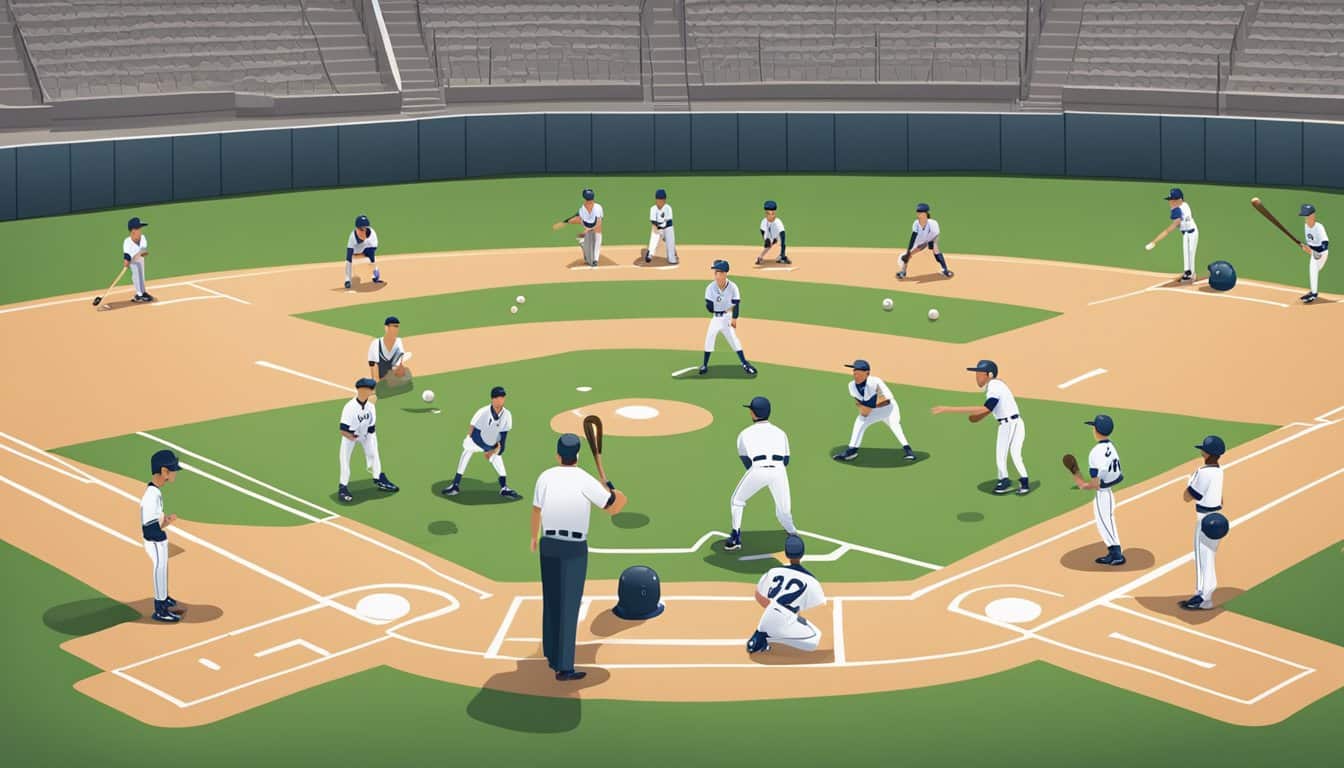Maximizing performance at the plate begins long before game day; it starts with effective practice sessions using a batting tee. The tee, often underestimated, serves as a fundamental training tool for developing a player’s swing mechanics and precision. By employing a systematic approach to batting tee sessions, players can build the muscle memory and confidence required for success in live situations.
Consistency is key when training with a batting tee. It allows hitters to focus on the minutiae of their swing in a controlled environment. This controlled setting is ideal for making incremental adjustments that contribute to a more powerful and accurate swing. Moreover, a batting tee provides instant feedback, enabling hitters to identify and correct flaws in real time.
Key Takeaways
- Effective batting tee sessions enhance swing mechanics and precision.
- Consistency on the tee aids in developing muscle memory for improved hitting.
- A batting tee offers immediate feedback, aiding in the refinement of a player’s swing.
Understanding the Batting Tee
https://www.youtube.com/watch?v=VBGjLcNTbLw&embed=true
The batting tee is a fundamental training tool used in both baseball and softball to develop a player’s batting skills. Mastery of tee work can result in significant improvements in a player’s swinging mechanics and hand-eye coordination.
Benefits of Using a Batting Tee
Consistent Practice: A batting tee provides a stationary target, allowing batters to focus on their swing technique without the variability of pitched balls. Consistency in practice leads to more refined muscle memory and better hitting mechanics.
Adjustable Training: It allows for adjustment in height and location, catering to a batter’s specific needs. Utilizing a batting tee helps in correcting swing path issues and tailoring training to target particular hitting zones.
Different Types of Batting Tees
Standard Tee: This is the most common type; it’s typically adjustable and suitable for players of all levels. They are used in both baseball and softball for practicing swing fundamentals.
Tanner Tee: Known for their durability and portability, Tanner Tees feature a flexible top that provides realistic ball feedback upon contact. They are popular among serious players for their ability to withstand extensive use.
Tee Ball Sets: Designed for beginners and young athletes, tee ball sets often include a tee, bat, and balls to introduce the basics of batting to novices in a simplified format.
Incorporating various types of tees into practice sessions can cater to different aspects of a player’s development, from the basics taught in tee ball to the advanced skills polished with a Tanner Tee.
Setting Up for Success
https://www.youtube.com/watch?v=diHt5j-rWjM&embed=true
In preparing for a productive batting tee session, the placement of the tee and the hitter’s stance are critical components for success.
Proper Tee Placement in the Batter’s Box
The position of the batting tee should align with the location of where the pitch would cross home plate. To simulate an inside pitch, place the tee closer to the batter’s box and slightly in front of home plate. For an outside pitch, the tee should be moved toward the opposite side of the batter’s box and lined up with the back point of home plate. This allows batters to practice hitting the ball at various points in their strike zone.
Key Points for Tee Placement:
- Inside Pitch: Batting tee is closer to the batter, in front of home plate.
- Outside Pitch: Batting tee is toward the far side of the batter’s box, aligned with the back of the plate.
Choosing the Right Batting Stance
A batter’s stance should be both comfortable and balanced, allowing for a full range of motion when swinging at the ball. A basic guidance for stance includes ensuring that the feet are shoulder-width apart and the knees are slightly bent. The batter’s front foot should be angled slightly towards home plate to maintain balance and generate power.
Stance Checklist:
- Feet shoulder-width apart
- Knees slightly bent
- Front foot slightly turned for stability
Adjustments in the stance can be made according to the batter’s preference, but the key is to maintain a posture that allows for quick and efficient movement while swinging the bat.
Developing Fundamental Skills
https://www.youtube.com/watch?v=Z7T9Q8LsJ7M&embed=true
Enhancing batting skills on a tee involves a focus on constructing a reliable swing and honing hand-eye coordination. These core aspects are crucial for a batter’s success at any level of play.
Creating a Consistent Swing
A consistent swing is paramount. Players should maintain a balanced stance and keep their eyes level to foster a repeatable swing. The following steps outline a strategy for refining swing mechanics:
- Stance: They should begin with their feet shoulder-width apart to ensure stability.
- Grip: The bat should be gripped firmly but not tensely, allowing flexibility in the wrists.
- Posture: Keeping the back straight and elbows in a comfortable, “ready” position is ideal for a swift, controlled swing.
- Swing Path: They need to practice driving the bat through the strike zone, ensuring that the bat path is straight and level to make consistent contact.
By concentrating on these fundamentals, a player can develop the muscle memory necessary for a consistent swing.
Mastering Hand-Eye Coordination
Hand-eye coordination is instrumental in making contact with the ball. To master this skill, the following activities are suggested:
- Tracking the ball: They should focus intently on the ball from the pitcher’s release to the swing’s impact point.
- Soft toss drills: A partner or coach gently tosses the ball in different locations, requiring the batter to adjust their swing.
- Varied tee heights: The tee should be adjusted to different heights to practice hitting pitches in various strike zone areas.
Practicing these drills regularly can significantly enhance a player’s timing and precision, ultimately improving their ability to make solid contact with the ball.
Maximizing Tee Drills
https://www.youtube.com/watch?v=ELo4zAOKTkg&embed=true
To develop an effective batting tee practice, one must concentrate on refining swing mechanics and boosting both power and contact.
Focusing on Swing Mechanics
In focusing on swing mechanics, hitters should employ a steady, repeatable approach to their swings. They need to:
- Establish a firm base: ensuring feet are shoulder-width apart, maintaining balance.
- Use slow-motion swings: to reinforce muscle memory for proper swing path and bat control.
- Stay inside the ball: practicing hitting drills that encourage the hitter to keep the bat’s barrel close to the body to ensure a compact swing.
Hitters should constantly assess and adjust their stance, grip, and follow-through, striving for efficiency in each movement.
Practicing Power and Contact
To enhance power and contact:
-
Power:
- Leverage the lower body, turning the hips aggressively to tap into core strength.
- Implement a slight uppercut swing to increase the chances of driving the ball with power.
-
Contact:
- Drill hitting different pitch locations by placing the tee in various positions across the strike zone.
- Use a two-strike approach with a shorter, quicker swing to prioritize making contact.
Hitters must focus on hitting through the ball with consistency, ensuring that power exercises do not compromise contact quality.
Advanced Batting Techniques
https://www.youtube.com/watch?v=Izf1E-0c8xc&embed=true
Mastering advanced batting techniques requires a player to focus on specific skills that enhance hitting performance. This section breaks down how hitters can work on hitting effectively to the opposite field and methods to improve bat speed and timing.
Working on Opposite Field Hitting
To effectively hit to the opposite field, players must develop a keen eye for pitch location and exercise precise swing adjustments. Inside-outside drills are highly beneficial for this purpose. They require the hitter to hit balls on the outer half of the plate to the opposite field, encouraging the use of the whole field. An effective drill involves:
- Set Up: Position the batting tee on the outside corner of home plate.
- Execution: Focus on hitting the ball to the opposite field gap.
- Key Point: Keep the hands inside the baseball to promote an inside-out swing path.
Improving Bat Speed and Timing
Improving bat speed and timing is pivotal for a batter’s success at the plate. Incorporating exercises that foster quick, decisive swings can lead to more power and better contact. These include:
-
Quick Hands Drill:
- Objective: To improve hand speed through the hitting zone.
- Method: Use a lighter bat to take regular swings, concentrating on a quick, compact swing.
-
Stride and Swing Drill:
- Objective: To synchronize the lower body’s movement with the swing for optimal timing.
- Method: Practice taking a stride and swinging in one fluid motion, ensuring the front foot lands as the bat begins its forward motion.
Through consistent practice focusing on these precise batting elements, players can make substantial improvements to their hitting capabilities.
Addressing Strike Zone Awareness
https://www.youtube.com/watch?v=U4d9dfkGJjo&embed=true
Strike zone awareness is a critical skill for batters to refine. Consistent practice is essential to identify and respond to pitches within the strike zone effectively.
Practicing Different Pitch Locations
A batter should systematically practice hitting pitches in various locations within the strike zone. The strike zone is the area over home plate between the bottom of the batter’s knees and the midpoint of their torso when in a batting stance. Effective drills involve:
- High Pitches: Focus on maintaining a level swing and making contact with the ball in the upper area of the strike zone.
- Low Pitches: Emphasize knee bend and adjust the swing to connect with lower pitches effectively.
- Inside Pitches: Practice turning on pitches closer to the body, ensuring the hands lead the barrel of the bat through the strike zone.
- Outside Pitches: Work on extending the arms and hitting the ball to the opposite field.
Creating a targeting grid that represents different pitch locations can be beneficial. Visual aids assist in recognizing where each ball falls in the strike zone and reinforce muscle memory when swinging.
Enhancing Pitch Recognition
Developing the ability to recognize different pitches as they approach is essential. Pitch recognition allows a batter to anticipate the ball’s flight path and timing, increasing the likelihood of making quality contact. Key methods include:
- Video Analysis: Use footage of different pitches to learn the visual cues associated with various pitch types.
- Pitch Machines: Set up a pitching machine to deliver specific types of pitches, allowing batters to focus on identifying and reacting to them in real time.
- Soft Toss Variations: Have a coach or partner toss balls from different angles to replicate different pitches.
- Tee Work: Place the tee in different zones of the strike area and practice hitting pitches as if they were coming from those locations. This helps the batter to make split-second decisions about whether or not to swing.
By integrating these techniques into a regular training regimen, a batter can enhance their strike zone awareness and improve their overall hitting performance.
Integrating Mental Approach
https://www.youtube.com/watch?v=kc40P5v4x5o&embed=true
A strong mental approach is crucial for translating batting tee practice into game success. It involves visualizing real-game situations and fostering a robust sense of confidence.
Visualizing Game Situations
Practicing with a batting tee affords players ample time to integrate visualization techniques. They should imagine various in-game scenarios, such as facing a two-strike count or hitting with bases loaded. A structured visualization might include:
- Pitch Type: Envisioning different pitches (fastballs, curveballs, etc.).
- Pitch Location: Imagining the ball coming into different zones of the strike zone.
By visualizing these scenarios, players can mentally rehearse their reactions and refine their swing accordingly.
Building Confidence at the Plate
Confidence at the plate is bolstered through consistent and purposeful tee work. Players can enhance their self-assurance by:
- Setting Achievable Goals: Short-term objectives can lead to quick wins and long-term confidence.
- Positive Self-Talk: Replacing negative thoughts with positive affirmations.
By methodically achieving set goals and maintaining positive reinforcement, players can foster a resilient mindset that translates into a confident presence during actual games.
Implementing Physical Adjustments
https://www.youtube.com/watch?v=fBNIsIOkSlI&embed=true
To enhance batting performance, precise adjustments to one’s grip and arm alignment, as well as stride and stability, are fundamental. These physical tweaks can result in significant improvements in power and accuracy.
Adjusting Grip and Arms
The grip on the bat should be firm yet relaxed, with the knuckles of both hands aligned. They should ensure that their grip is neither too tight—which can restrict wrist movement and thus power—nor too loose, which can lead to a lack of control. The correct arm positioning is equally critical, with the elbows bent slightly and shoulders level. This stance facilitates a compact and powerful swing.
- Grip Strength: Firm but relaxed
- Knuckle Alignment: Aligned for optimal control
- Elbow Position: Slightly bent
- Shoulder Leveling: Keep shoulders level for a balanced swing
Optimizing Stride and Stability
A batter’s stride is a pivotal element of an effective swing. They must employ a controlled and direct stride towards the pitcher, avoiding any excessive movement that can throw off balance. Perfecting the stride ensures they are in a strong, stable position to hit the ball with maximum force. Stability throughout the swing is sustained by keeping the head still and eyes level, with weight distributed evenly across both legs.
- Stride Direction: Toward the pitcher, controlled, and direct
- Balance: Even weight distribution
- Head Position: Still, to maintain focus
- Eye Level: Consistent, for better tracking of the ball
Strategic Practice Routines
In structuring batting tee sessions, the ideal approach combines repetitive skill enhancement with situational live pitching practice. A well-planned routine can significantly advance a hitter’s proficiency.
Balancing Tee Work and Live Pitching
Tee Work: Utilizing a batting tee allows hitters to focus on their swing mechanics without the variable of pitch timing. It’s crucial to incorporate tee work regularly as it reinforces muscle memory and improves bat path consistency. Here’s how to balance the two:
- Frequency: Engage in tee work 4-5 times a week, dedicating 15-20 minutes per session to isolate and refine various hitting aspects.
- Progression: Begin with basic swing mechanics, then move to simulate pitch locations and speeds.
Live Pitching: Complement tee work with live pitching to translate those skills into game-like scenarios.
- Application: Schedule live pitching sessions at least twice a week to test and apply the skills learned from tee work in real time.
- Variety: Incorporate a mix of fastball and off-speed pitches to mirror game conditions.
Structured Drills for Skill Development
Drill Progression: A systematic approach to drills can significantly boost skill acquisition.
- Start With the Basics: Ensure the hitter’s stance, grip, and posture are correct before tackling more advanced techniques.
- Build Complexity: Gradually incorporate movement variations and swing decisions to replicate different pitch types and locations.
Feedback Loop: Immediate feedback is essential in reinforcing proper technique and correcting errors.
- Video Analysis: Record sessions and analyze swings after each set of repetitions to identify areas for improvement.
- Coach’s Input: Regular input from a coach or experienced player can provide actionable insights for skill enhancement.
Structured practice routines, blending regular tee work with dynamic live pitching scenarios, can help batters refine their technique and develop a keen understanding of various pitches. Employing structured drills with consistent feedback cultivates an environment where skill development is measurable and targeted.
Utilizing Feedback and Adjustments
https://www.youtube.com/watch?v=bM0FDJSxSQA&embed=true
When engaging in batting tee sessions, the use of feedback is crucial. It allows hitters to make the necessary adjustments to hone their swing. Assessing the point of contact and swing path, and refining techniques in real-time, enhances proficiency at the plate.
Analyzing Contact Point and Swing Path
A batter must ensure that the ball is consistently struck at the contact point, ideally at the sweet spot of the bat. This is the area on the bat where the impact feels the least jarring and drives the ball most effectively. To achieve this, athletes should:
- Assess Impact: Compare where the ball is being hit on the bat with the desired sweet spot.
- Evaluate Swing Path: Observe the bat’s trajectory to determine if the swing is level, upward, or downward.
Making Real-time Adjustments During Drills
To develop a consistent and powerful swing, batters must adapt their techniques on the fly. Real-time adjustments are informed by the feedback garnered from each swing and can include:
-
Adjusting Stance:
- Wider or Narrower: Determine if altering the width of the stance impacts the swing positively.
- Closer or Farther: Experiment with the distance from the tee to find the optimal contact point.
-
Modifying Swing Mechanics:
- Hand Position: Shift hands up or down the bat to alter the leverage and angle of the swing.
- Hip and Shoulder Alignment: Rotate hips and shoulders to fine-tune swing direction and power.
By incorporating these changes, the batter can immediately feel the improvement in their swing and make the necessary tweaks. This process is iterative and requires constant evaluation and application of constructive feedback.
Physical Conditioning for Batting
https://www.youtube.com/watch?v=U6ozK2DMZPE&embed=true
Physical conditioning is crucial for enhancing batting performance. Specifically, targeted exercises can significantly improve power and efficiency at the plate through improved hip rotation and overall muscular strength.
Exercises to Enhance Hitting Performance
To boost hitting performance, the athlete should focus on a balanced workout regimen that encompasses both core stability and upper body strength. A selection of exercises is recommended:
- Core Exercises: Planks, Russian twists, and medicine ball slams build the core muscles, which are vital for a solid batting stance and swing.
- Upper Body Strength: Push-ups, dumbbell rows, and bench presses enhance the strength of the shoulders, chest, and back, contributing to a more powerful swing.
Each exercise should be performed with proper form to maximize benefits and reduce the risk of injury.
Incorporating Hip Rotation for Power
Hip rotation is a key component of a powerful batting swing. The following drills can be incorporated into training sessions to improve hip rotation:
-
Hip Rotation Drill:
- Start by assuming a batting stance with a relaxed upper body.
- Rotate the hips as if swinging, but keep the shoulders and bat still to isolate the hip movement.
- Repeat this drill to increase fluidity and power in the hip rotation component of the swing.
-
Running and Throwing:
- Running: Sprints and agility drills enhance leg strength, which contributes to a more explosive hip rotation.
- Throwing: Practice throwing with an emphasis on rotating the hips to mirror the motion in batting, thus improving the muscle memory related to hip rotation.
These exercises, when incorporated into regular training, can lead to improved batting performance through enhanced strength and hip rotation mechanics.
Frequently Asked Questions
In this section, readers will find targeted information on utilizing batting tees to refine baseball skills through specific drills and techniques.
What drills can enhance hip rotation during baseball swing practice?
To enhance hip rotation, players can focus on drills that emphasize turning the back foot and using the hips to drive the swing. The use of a mirror or video to provide visual feedback is an effective way to monitor and correct hip movement.
How can a batting stick be utilized effectively for training sessions?
A batting stick can be used to improve hand-eye coordination and precision. Players should aim to strike the smaller target of the batting stick consistently, which helps refine their swing mechanics and accuracy.
What techniques can increase hitting power when practicing with a batting tee?
Hitters can increase power by practicing rotational swings and focusing on driving through the ball with their legs and core. Isolating the lower body and practicing weight transfer from the back leg to the front can also contribute to a more powerful swing.
In what ways does regular practice with a batting tee improve hitting skills?
Regular practice with a batting tee helps improve a player’s swing mechanics, consistency, and timing. It allows for repetition of the swing in a controlled setting, enabling the player to make adjustments and work on striking the ball in various strike zone areas.
Which fielding and throwing drills complement batting tee sessions to develop overall baseball abilities?
Incorporating drills like ground ball fielding and crow hop throwing can help develop a well-rounded skill set. Doing these drills alongside batting tee practice can create a more comprehensive training session focused on both offensive and defensive skills.
How can one practice baseball throwing accuracy effectively alongside batting tee exercises?
Players can practice throwing to a target from various distances to improve their accuracy. Integrating this with batting tee practice can maintain a player’s throwing arm strength and precision, crucial for defensive gameplay.










